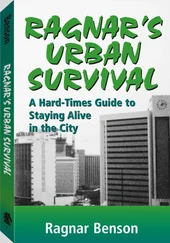Ragnar Benson - Ragnar's Urban Survival - A Hard-Times Guide to Staying Alive in the City
Здесь есть возможность читать онлайн «Ragnar Benson - Ragnar's Urban Survival - A Hard-Times Guide to Staying Alive in the City» весь текст электронной книги совершенно бесплатно (целиком полную версию без сокращений). В некоторых случаях можно слушать аудио, скачать через торрент в формате fb2 и присутствует краткое содержание. Год выпуска: 2009, ISBN: 2009, Жанр: Старинная литература, на английском языке. Описание произведения, (предисловие) а так же отзывы посетителей доступны на портале библиотеки ЛибКат.
- Название:Ragnar's Urban Survival: A Hard-Times Guide to Staying Alive in the City
- Автор:
- Жанр:
- Год:2009
- ISBN:1581600593
- Рейтинг книги:5 / 5. Голосов: 1
-
Избранное:Добавить в избранное
- Отзывы:
-
Ваша оценка:
- 100
- 1
- 2
- 3
- 4
- 5
Ragnar's Urban Survival: A Hard-Times Guide to Staying Alive in the City: краткое содержание, описание и аннотация
Предлагаем к чтению аннотацию, описание, краткое содержание или предисловие (зависит от того, что написал сам автор книги «Ragnar's Urban Survival: A Hard-Times Guide to Staying Alive in the City»). Если вы не нашли необходимую информацию о книге — напишите в комментариях, мы постараемся отыскать её.
Ragnar's Urban Survival: A Hard-Times Guide to Staying Alive in the City — читать онлайн бесплатно полную книгу (весь текст) целиком
Ниже представлен текст книги, разбитый по страницам. Система сохранения места последней прочитанной страницы, позволяет с удобством читать онлайн бесплатно книгу «Ragnar's Urban Survival: A Hard-Times Guide to Staying Alive in the City», без необходимости каждый раз заново искать на чём Вы остановились. Поставьте закладку, и сможете в любой момент перейти на страницу, на которой закончили чтение.
Интервал:
Закладка:
First-timers are usually shocked and discouraged to discover how little edible meat remains of a once large, plump critter.
PRESERVING MEAT
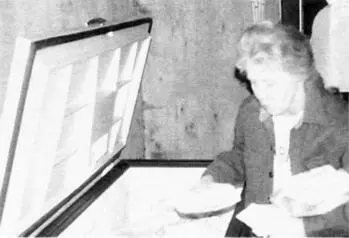
Freezing meat and vegetables, even if a generator is required, is often the quickest, safest, easiest, and most nutritious method of preserving food.
Processing now depends on what prior preparations have been made and what tools and materials are in your inventory. The simplest way, of course, is to crank up the generator to power a freezer. But we already know there won't be sufficient generators for all city survivors.
Brining
Nutrition, quality, aesthetics, and versatility suffer to some extent, but red meat, poultry, and fish can be preserved in salt brine. Plastic wastebaskets are ideal as brine tanks. Almost everyone already has these.
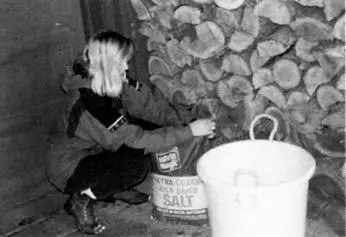
Salt-curing meat and some vegetables is possible using plastic waste baskets and large quantities of salt.
Common rock salt (NaCl) is the staff of life of any primitive survival program. City survivors are also going to have to have lots of it in hand before the crisis hits. No reason not to stockpile salt, even in a 31st floor condo deep within a city. Salt is dirt cheap, it stores well, and doesn't easily go out of condition as long as the bags are kept intact and dry. If all else fails, salt will be a hugely valuable trade good.
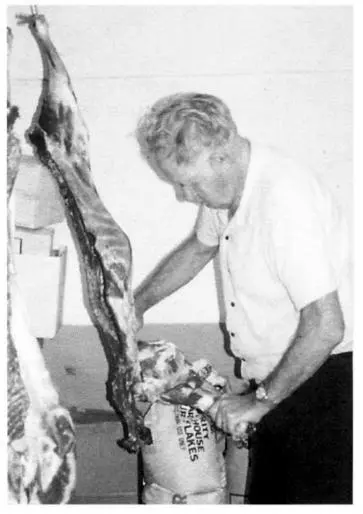
Cut meat into 1 1/2 to 2-pound chunks before brining.
Using clean, filtered, purified water, mix up half a plastic wastebasket of salt and water of sufficient strength to float an egg or russet-type baking potato. Low-solid Red Pontiac potatoes will give a false reading. There's not enough salt in the water to preserve meat when using these as a gauge.
All dense beef, goat, and dog meat should be cut into 1 1/2- to 2-pound chunks. Larger chunks brine too slowly. Spoilage may occur inside, especially around bones. Professionals brine using a syringe-like tool to inject salt water into really large ham-sized pieces of meat.
Ground meat can be successfully kept in brine, but it does turn gray, fall apart, and degrade a bit. Later it can be filtered or skimmed out of the brine with a sieve or screen. The question is, are the results better in brining chunks of meat that are later ground into burger, or grinding first and then brining? Try it either way
All brined meat tastes better if it is boiled in water and repeatedly rinsed. Brined burger must be repeatedly soaked to make it edible.
Fish, fowl, and even pork and beef are best brined and stored separately Poultry, which are essentially hollow, can be brined without chunking or boning. Brine containers easily become heavy and unwieldy and should be placed in a cool, protected area out of the sun and away from dust and dirt. Properly brined meat easily keeps for 2 or 3 years.
Smoking
Light brining is a half-step toward preservation by smoking. It is unclear whether salt saturation or smoke penetration adds shelf life. At any rate, brining and smoking seem not to lead to longterm storage. Meat, heavily brined or smoked, in a fairly hot fire only seems to keep 2 or 3 months at best. Lightly brined and smoked meat may not keep at all-a week or 10 days in hot weather, maximum.
Smoking can be undertaken in virtually any closed container that will house a small heat source on which some chips of hickory or apple wood are placed. Kettle cookers, regular little steel smoker boxes, wooden boxes, old refrigerators, and even heavy cardboard boxes all have been used as smokers. The heat source can be a couple of pieces of charcoal, an old electric hot plate, or even an old electric oven. I have even seen a propane torch used as a heat source in a small smoker. The plan is to close off the oxygen supply in the smoker box drum, container, or whatever, producing lots of dense smoke without flame.
Here we want to penetrate the meat with as much smoke as possible, using as little heat as possible. Cooking the meat is not desirable. If a thermometer is available, keep temperatures down around 140 degrees. If you don't have a thermometer, keep it comfortably warm, but not hot to the touch.

Mason jars, lids, and rings for home canning.
Personally I have spoiled lots of meat trying to keep it too long after smoking. In a nonsurvival circumstance, smoked meat can be stored in the refrigerator until consumed. The only way to know for sure in your climate is to experiment now while it's not life and death.
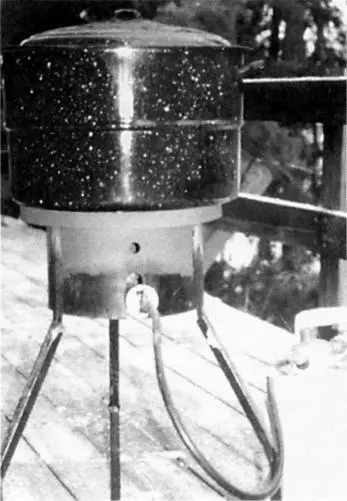
A home canning pot sits on a small, portable propane stove. Canning can be done virtually anywhere as long as supplies of LP gas hold out.
Canning
Canning meat in glass jars is a bit risky and time consuming, but certainly is possible. For about 200 years it was a preservation method of choice. But when meat is cooked insufficiently long in large batches, it can turn to poison in the oxygen-free environment inside of glass jars. There are several precautions that can be taken that minimize the risk. Unfortunately, they simultaneously degrade the quality of the meat.
A large propane cooker, canner pot, or pressure cooker, canning jars, lids, and an abundant supply of jar lid hold-down rings are required to can both meat and vegetables. Without prior positioning of these vital supplies, there is little reason to rely on this method of preservation. Extra lids, hold-down rings, and canning jars are very inexpensive. Thirty dollars buys several years' supply, but it will take at least $100 to purchase a 7-quart pressure cooker. Pressure cookers are also used to cook up old, tough, or otherwise inedible meat.
Home canning of fruits and some vegetables is relatively easy Both meat and vegetables can be done in a regular water bath with an open kettle, though the results are speedier and more certain using a pressure cooker. Country people, who tend to process their own food, might already own a pressure cooker. For city survivors, ownership of a pressure cooker will be a pure buy-it-now-to-putin-storage play.
Start by cutting all meat into chunks of 1 pound or less. Brown these pieces thoroughly in an open pan on the propane stove. Brown slowly for about 20 minutes, till all red and pink disappear from the meat. Stuff the piping-hot meat chunks into canning jars. Quart jars store a great deal more meat, but pints-especially without a pressure cooker-are quicker and easier to boil and are sterilized with greater certainty. Most survivors limit home meat canning to pint jars when they don't have a pressure cooker.
Add 1 teaspoon of salt to each meat-packed jar. All jars, reused or new, must be thoroughly washed clean and scalded to be sterile. Fill the jars entirely with boiling water, driving all air out. Ensuring proper sterilization requires that quarts of meat be boiled four hours in an open water bath or 1 1/2 hours in a pressure cooker. Pints can be boiled in the open for 3 1/2 hours in an open bath or for 1 hour in a pressure cooker. Obviously this will take lots of energy. Pressure cookers quickly pay for themselves in time and energy saved.
Читать дальшеИнтервал:
Закладка:
Похожие книги на «Ragnar's Urban Survival: A Hard-Times Guide to Staying Alive in the City»
Представляем Вашему вниманию похожие книги на «Ragnar's Urban Survival: A Hard-Times Guide to Staying Alive in the City» списком для выбора. Мы отобрали схожую по названию и смыслу литературу в надежде предоставить читателям больше вариантов отыскать новые, интересные, ещё непрочитанные произведения.
Обсуждение, отзывы о книге «Ragnar's Urban Survival: A Hard-Times Guide to Staying Alive in the City» и просто собственные мнения читателей. Оставьте ваши комментарии, напишите, что Вы думаете о произведении, его смысле или главных героях. Укажите что конкретно понравилось, а что нет, и почему Вы так считаете.


